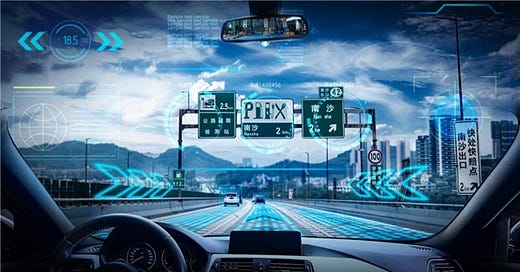China's Assisted Driving Landscape and Why Tighter Regulations May Have Limited Impact
In March 2025, a Xiaomi SU7 electric sedan, operating under an assisted driving mode, collided with a roadside barrier during highway construction. The crash, which tragically killed three university students, shocked the public and brought China's entire smart driving industry under the spotlight. It quickly raised questions about overpromising marketing language, the limits of L2 systems, and the lack of user understanding. In response, Chinese regulators accelerated their efforts to rein in the sector.
In recent years, China's automotive industry has become a hotbed for innovation in advanced driver-assistance systems (ADAS). Startups, tech giants, and traditional automakers are aggressively pushing the boundaries of assisted driving. Yet, in the spring of 2025, a sharp shift occurred: Chinese regulators, led by the Ministry of Industry and Information Technology (MIIT), cracked down on misleading marketing and accelerated efforts to regulate over-the-air (OTA) updates and feature naming in smart driving systems. Despite the headlines, many industry insiders claim the impact is limited. Why?
Key Players and Their Tech Paths
China's assisted driving landscape is defined by a few key players:
Huawei: While it doesn’t build cars, Huawei powers them with its ADS 2.0 system. It emphasizes a high-sensor fusion strategy and "mapless" driving using vision + LiDAR + radar. Vehicles like AITO’s M5 have already deployed Huawei’s end-to-end driving stack in several cities.
Xpeng Motors: Known for full-stack R&D and rapid OTA updates, Xpeng’s XNGP (Navigation Guided Pilot) blends BEV (Bird’s Eye View) and Transformer models to create a 4D perception system. It operates city NGP in many first-tier cities and aims to deploy AI-based valet driving.
Li Auto: Taking a dual-path approach, it uses Horizon Robotics chips in mid-range models and Nvidia Orin for its high-end ones. Li Auto’s AD Max stack integrates LiDAR, BEV, and language models for end-to-end autonomy. Though once known for fast OTA cycles, it is now slowing down in response to new rules.
NIO: It deploys the Aquila sensor suite (33 sensors including LiDAR) and uses Orin chips to power NAD (NIO Autonomous Driving). NIO also follows a subscription model. While its advanced algorithms have seen delays due to regulatory approvals, the company is pursuing L3 trials in a compliant framework.
BYD: China’s EV sales leader has aggressively pushed assisted driving to mass-market models. Even the budget Seagull model supports basic ADAS. It is also investing heavily in homegrown sensor fusion and planning BEV-based solutions for high-end vehicles.
Xiaomi Auto: A latecomer with ambition, Xiaomi’s SU7 sedan aims to offer high-spec driving features via full-stack development. But after a fatal highway crash involving a vehicle in assisted mode, it faces intense regulatory scrutiny.
Why the Crackdown?
MIIT’s move toward stricter regulation stems from several causes:
High-profile accidents: A fatal crash involving Xiaomi’s SU7 in March 2025, where a driver misjudged the system’s limits, echoed earlier tragedies involving NIO and Tesla. Authorities are increasingly concerned that misleading marketing leads to overreliance on ADAS.
Misleading advertising: Terms like "autonomous driving," "hands-free," or "driverless" have been used liberally in past marketing, even for L2 systems that still require full driver attention. Regulators now require accurate, clearly demarcated language to set user expectations.
Feature creep beyond legal bounds: L2 systems have quietly added functions like remote parking or auto-summon, which resemble L3 or L4 features. Authorities now prohibit any feature that allows a vehicle to move without driver oversight.
OTA transparency: Automakers frequently used OTA updates to roll out unverified beta features or silently fix bugs—sometimes dodging recall obligations. Under new rules, any OTA update affecting driving behavior must pass regulatory review.
Why Insiders Say the Impact Is Minimal
Despite the regulatory tightening, industry insiders are unfazed. Here’s why:
Marketing pivot is easy: Instead of calling it "autonomous driving," automakers now say "advanced driver assistance." With a few script rewrites and UI tweaks, the message remains the same: our tech is still impressive.
OTA strategies adapt: Companies are reducing update frequency but increasing quality. Xpeng, NIO, and Li Auto have shifted from monthly updates to more rigorously tested quarterly cycles. This may improve user experience over time.
No major tech rollback: The core R&D paths remain unchanged. Huawei continues its vision-LiDAR fusion, Xpeng invests in Transformer-based perception, and Li Auto refines its end-to-end stack. Regulatory compliance has just become a necessary step in deployment.
Legal workarounds emerge: Companies are testing remote valet parking in closed parks, rebranding functions, or requiring driver proximity to enable semi-autonomous tasks. It’s all about aligning language with regulation while keeping capabilities intact.
Stronger user education: DMS (Driver Monitoring Systems) are being upgraded to detect driver inattentiveness more precisely. Automakers are also incorporating pop-up warnings and clearer training materials at handover.
Keep reading with a 7-day free trial
Subscribe to Pandaily to keep reading this post and get 7 days of free access to the full post archives.




